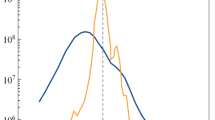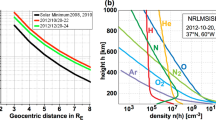Abstract
We have studied the loss of O+ and O+ 2 ions at Mars with a numerical model. In our quasi-neutral hybrid model ions (H+, He++, O+, O+ 2) are treated as particles while electrons form a massless charge-neutralising fluid. The employed model version does not include the Martian magnetic field resulting from the crustal magnetic anomalies. In this study we focus the Martian nightside where the ASPERA instrument on the Phobos-2 spacecraft and recently the ASPERA-3 instruments on the Mars Express spacecraft have measured the proprieties of escaping atomic and molecular ions, in particular O+ and O+ 2 ions. We study the ion velocity distribution and how the escaping planetary ions are distributed in the tail. We also create similar types of energy-spectrograms from the simulation as were obtained from ASPERA-3 ion measurements. We found that the properties of the simulated escaping planetary ions have many qualitative and quantitative similarities with the observations made by ASPERA instruments. The general agreement with the observations suggest that acceleration of the planetary ions by the convective electric field associated with the flowing plasma is the key acceleration mechanism for the escaping ions observed at Mars.
Similar content being viewed by others
References
Barabash, S., Holmström, M., Lukyanov, A., and Kallio, E.: 2002, J. Geophys. Res. A10, 1280, JA000326.
Barabash, S., et al.: 2004, ESA publication SP-1240, 121.
Brecht, S. H., Ferrante, J. F., and Luhmann, J. G.: J. Geophys. Res. 98, 1345.
Dubinin, E., and 39 co-authors: 2006, Icarus 182(2), 337, doi:10.1016/j.icarus.2005.05.022.
Espley, J. R., Cloutier, P. A., Brain, D. A., Crider, D. H., and Acuña, M. H.: 2004, J. Geophys. Res. 109, doi:10.1029/2003JA010193.
Fedorov, A., and 44 co-authors: 2006, Icarus 182(2), 329, doi:10.1016/j.icarus.2005.09.021.
Kallio, E., Koskinen, H., Barabash, S., Nairn, C. M. C., and Schwingenschuh, K.: 1995, Geophys. Res. Lett. 22, 2449.
Kallio, E., Koskinen, H., Barabash, S., Lundin, R., Norberg, O., and Luhmann, J. G.: 1994, J. Geophys. Res. 99(A12), 23,547.
Kallio, E., and Koskinen, H.: 1999, J. Geophys. Res. 104, 557.
Kallio, E., and Janhunen, P.: 2002, J. Geophys. Res. 107, A3.
Kallio, E., and 46 co-authors: 2006, Icarus 182(2), 350, doi:10.1016/j.icarus.2005.09.018.
Lammer, H., Lichtenegger, H. I. M., Biernat, H. K., Erkaev, N. V., Arshukova, I. L., Kolb, C., et al.: 2006, Planetary and Space Science, in press.
Liu, Y., Nagy, A. F., Groth, C. P. T., DeZeeuw, D. L., Gombosi, T. I., and Powell, K. G.: 1999, J. Geophys. Res. 26, 2689.
Lundin, R., and 44 co-authors: 2004, Science 305(5692), 1933, DOI: 10.1126/science.1101860.
Lundin, R., and 22 co-authors: 2006, Science 311(5763), 980, DOI: 10.1126/science.1122071.
Lundin, R., and 43 co-authors: 2006, Icarus 182(2), 308, doi:10.1016/j.icarus.2005.10.035.
Tanaka, T.: 1993, J. Geophys. Res. 98(A10), 17,251.
Terada, N., Machida, S., and Shinagawa, H.: 2002, J. Geophys. Res. 107(A12), 1471, doi:10.1029/ 2001JA009224.
Winningham, J. D., and 44 co-authors: 2006, Icarus 182(2), 360, doi:10.1016/j.icarus.2005.10.033.
Author information
Authors and Affiliations
Corresponding author
Rights and permissions
About this article
Cite this article
Kallio, E., Fedorov, A., Barabash, S. et al. Energisation of O+ and O+ 2 Ions at Mars: An Analysis of a 3-D Quasi-Neutral Hybrid Model Simulation. Space Sci Rev 126, 39–62 (2006). https://doi.org/10.1007/s11214-006-9120-z
Received:
Accepted:
Published:
Issue Date:
DOI: https://doi.org/10.1007/s11214-006-9120-z




